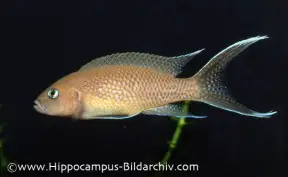Neolamprologus marunguensis
Classification
Cichlidae
Distribution
Endemic to Lake Tanganyika, around the southwestern shore of the lake.
Habitat
Areas of shoreline with rocky substrates.
Maximum Standard Length
Males to 2.4″ (6cm), females to 2″ (5cm).
Aquarium SizeTop ↑
30″ x 12″ x 12″ (75cm x 30cm x 30cm) – 70 litres is suitable for a single pair.
Maintenance
Should be housed in a Lake Tanganyika biotope setup, with piles of rocks arranged to form caves filling much of the aquarium. A sandy substrate is preferable.
Water Conditions
Temperature: 73-81°F (23-27°C)
pH: 7.5-9.0
Hardness: 8-25°H
Diet
Live and frozen foods should comprise a large proportion of the diet. Dried foods can be fed, but less often. Some vegetable matter, such as spirulina or blanched spinach should also be fed.
Behaviour and CompatibilityTop ↑
A relatively peaceful species, although very territorial when breeding and is best kept in a species tank. However in large tanks it can be maintained successfully with other small to medium-sized Tanganyikan cichlids that occupy different areas of the tank such as Cyprichromis species. Other rockdwellers such as Julidochromis or Altolamprologus are possibilities if the tank is large enough and sufficient territories are provided. It should not be kept with mbuna or other boisterous species.
Sexual Dimorphism
A difficult species to sex. Adult males are usually slightly larger and develop longer extensions to the dorsal and caudal fins than females.
Reproduction
Quite easy. Cave spawner. We suggest the purchase of a group of at least six young fish and allowing these to pair off naturally. The breeding tank should be at least 30″ in length (or larger depending on the size of the initial group) and set up as suggested above. The pH should be around 8.2-9.0 and the temperature 77-80°F. It is far better if no other species are present, though N. marunguensis will often breed in a community situation. Condition the group with a good varied diet as above. The fish will swim together as a group and pair off to spawn, retaining the pair bond for future spawns. A pair will spawn secretly in a cave which they often excavate themselves, with the female laying her eggs on the wall or roof of it. Once spawning has occured, the female will tend to the eggs while the male guards the area around the cave. The eggs will hatch in 2-3 days, with the fry becoming free swimming at around the 7 day stage.
The fry are large enough to take brine shrimp nauplii from birth but are quite slow growing. Brood care is quite long-lived and previous generations of fry are permitted to remain with the parents until they reach sexual maturity. The parents will continue to spawn and several generations can often be seen coexisting in the same aquarium.
NotesTop ↑
A less often seen but good looking species with a deeply forked tail. It was previously sold as Neolamprologus sp. “walteri”.

-ft-A48257-1-288x192.jpg)


November 21st, 2012 at 7:44 pm
Confirmed almost 10cm indivuduals housed in 220 litres aquarium. They were mistaken for N. brichardi species, but are practically same as shown here on this site.
There’s also confirmation of size on cichlid site, where it is said to be 3″ long.
November 21st, 2012 at 8:08 pm
Also 3rd photo here is another species. Presumably N. brichardi. The blue and black markings on the head are the proof. They shouldn’t be visible on juvenile N. marunguensis.
November 22nd, 2012 at 10:36 am
Removed 3rd photo but again, this profile is in need of help in general. @ Sverting – is that 10 cm SL or TL?
November 22nd, 2012 at 6:17 pm
What does it mean? I’m Polish, so I’m unfamiliar to most abbreviations used here.
November 22nd, 2012 at 7:25 pm
Ah, sorry about that!
SL = standard length. This is the length of the fish from the tip of the snout to the base of the caudal-fin. It is the measurement we use in profiles here.
TL = total length. This is the length of the fish from the tip of the snout to the tip of the longest caudal-fin lobe.
Here’s a diagram which might help. 🙂 Fish measurements
November 26th, 2012 at 3:17 pm
TL of the dominant male is 12cm, the submissive one is 10 cm long (TL) . Females are 8 cm long each(TL). Fry when they first swam out of the hiding were 1,5 cm long.
So the dominant male SL equals at least 8 cm.
February 11th, 2019 at 4:41 pm
”So the dominant male SL equals at least 8 cm.” This information certainly correct.The adult males bigger than 11 cm.
Also the second photo is not marunguensis.İt is a neolamprologus gracilis, in my opinion.